Vet Tech Anesthesia & Surgical Procedures – Flashcards
Unlock all answers in this set
Unlock answersquestion
Anesthesia
answer
Loss of sensation & sensitivity to pain
question
Anesthesia provides?
answer
Sedation, tranquilization, immobility, muscle relaxation, unconsciousness, & pain control
question
Anesthesia indications?
answer
Surgery, dentistry, grooming, diagnostic imaging, & wound care
question
General Anesthesia
answer
Reversible state of unconsciousness, immobility, muscle relaxation, & loss of sensation
question
Surgical Anesthesia
answer
Specific stage of general anesthesia
question
Analgesia
answer
Loss of sensitivity to pain
question
Sedation
answer
Drug-induced, CNS depression, drowsiness, various intensity, minimally aware or unaware of surroundings, aroused by noxious stimulation, indications (minor procedures, imaging, grooming, wound treatment)
question
Tranquilization
answer
Drug-induced state of calm, reluctant to move, aware of surroundings but not concerned
question
Hypnosis
answer
Drug-induced sleeplike state, impaired ability to respond to stimuli, aroused w/sufficient stimulation
question
Narcosis
answer
Drug-induced sleep, not easily aroused, associated w/narcotic drugs
question
Local Anesthesia
answer
Loss of sensation in a small specific area of the body
question
Topical Anesthesia
answer
Loss of sensation of a localized area
question
Regional Anesthesia
answer
Loss of sensation to a larger but limited area of the body (epidural)
question
Balanced Anesthesia
answer
Administration of multiple drugs in smaller quantities, maximizes benefits, & minimizes ASE
question
Signalment
answer
Species, Breed, age, sex, reproductive status
question
What species are more sensitive to opioids than Dogs & Ruminants?
answer
Horses & Cats
question
What specie has a rougher recovery from inhalants?
answer
Horses
question
Anticholinergics can make saliva thick & ropy, causing airway occlusion in what specie?
answer
Ruminants
question
Ruminants are more sensitive to what medication than Horses?
answer
Xylazine
question
What is prone to respiratory depression & dependent atelectasis, requiring more ventilatory support?
answer
Large animals
question
What specie can tolerate dissociative agents used alone?
answer
Cats
question
What specie may experience seizure-like activity?
answer
Dogs
question
What may experience pressure necrosis of tissues lying over pressure points & require padding when laterally recumbent?
answer
Large animals
question
What species are prone to excess airway secretions that may result in airway blockage?
answer
Cats & Ruminants
question
Horses may what during recovery?
answer
Fracture limbs
question
What species are prone to hypoxemia & hypercarbia caused by ? mechanical dead space?
answer
Cats, small Dogs, small pediatric patients
question
What specie are prone to bloat?
answer
Ruminants
question
What breeds are sensitive to barbiturates?
answer
Sighthounds
question
What breeds are more sensitive to Acepromazine?
answer
Boxers & Giant breeds
question
What breeds are more resistant to Acepromazine?
answer
Terriers
question
What breeds are difficult to intubate?
answer
Brachycephalic
question
What breeds are sensitive to sedatives?
answer
Draft Horses
question
Acepromazine is contraindicated in what & why?
answer
Stallions, may cause penile prolapse
question
Xylazine causes what in pregnant Cows & Ewes?
answer
Uterine contractions in the 3rd trimester
question
Epinephrine (sympathomimetic) combined with what can cause cardiac arrhythmias?
answer
Cyclohexamines, Xylazine, Barbiturates, & Halothane
question
Tricyclic Antidepressants (Amitriptyline & Clomipramine) can cause?
answer
Cardiac arrhythmias
question
Antibiotics (Chloramphenicol) can cause?
answer
? biotransformation of Barbiturate Anesthetics & lead to prolonged recovery
question
Monoamine Oxidase Inhibitors (Amitraz & Selegeline) can?
answer
? effects of Morphine & other opioids, & lead to additive effects w/Anticholinergics or CNS depressants
question
Antihistamines can cause?
answer
CNS & respiratory depression w/Opioids
question
Hydration assessment can be seen by?
answer
Skin turgor, placement of eye in the orbit, MM color, CRT, moisture level, HR, & pulse strength
question
What are recommended tests for Dogs/Cats w/ class P1 to P2 & < 5 yrs old?
answer
PCV & TP
question
What are recommended tests for Dogs/Cats w/ class P1 to P2 & > 5 yrs old?
answer
CBC / Chemistry
question
What are recommended tests for Dogs/Cats w/Class P3-P5 & any age?
answer
As ordered by VIC
question
What are recommended tests for Ruminants w/Class P1 to P2 @ any age?
answer
PCV & TP
question
What are recommended tests for Ruminants w/Class P3-P5 @ any age?
answer
As ordered by VIC
question
What are recommended tests for Horses w/Class P1 to P2 @ any age?
answer
CBC & TP
question
What are recommended tests for Horses w/Class P3-P5 @ any age?
answer
As ordered by VIC
question
ASA Physical Status 1?
answer
Normal healthy, minimal risk, elective procedures
question
ASA Physical Status 2?
answer
W/mild systemic disease, low risk, neonatal, geriatric, obese, mild dehydration, &/or skin tumor
question
ASA Physical Status 3?
answer
W/severe systemic disease, moderate risk, anemia, moderate dehydration, compensated major organ disease
question
ASA Physical Status 4?
answer
W/severe systemic disease that is constant threat to life, high risk, ruptured bladder, internal hemorrhage, pneumothorax, &/or pyothorax
question
ASA Physical Status 5?
answer
Moribund patient who is not expected to survive w/o the operation, extreme risk, severe head trauma, GDV (Gastric Dilation Volvulus), &/or pulmonary embolism
question
Total Body of Water?
answer
Intracellular & Extracellular fluid
question
Intracellular fluid is?
answer
In cells & is 2/3 of TBW
question
Extracellular Fluid is?
answer
Not in cells & is 1/3 of TBW
question
Intravascular Fluid is?
answer
1/4 of ECF, & is outside the cells but inside the vessels
question
Interstitial Fluid is?
answer
3/4 of ECF & is in between the cells
question
Plasma is what % of BW?
answer
5%
question
Blood volume is what % of BW in Dogs & large animals?
answer
8-9%
question
Blood volume is what % of BW in Cats?
answer
6-7%
question
Calculating Blood volume for Dogs & large animals is?
answer
90mL/Kg. lean BW
question
Calculating Blood volume for Cats is?
answer
60mL/Kg. lean BW
question
Intrcellular cocentration solutes are?
answer
K?, Mg²?, Protein, & Phosphate
question
Extracellular concentration solutes are?
answer
Na?, Cl?, & HCO??
question
1/3 of IV fluids administered will?
answer
Stay in the intravascular space
question
2/3 of IV fluids administered will?
answer
Diffuse into the interstitial space
question
What doesnt pass freely through the vascular endothelium?
answer
Colloids
question
Colloids in the intravascular space draw?
answer
Water into the space, creating osmotic or oncotic pressure
question
Dehydration, Anorexia, & General disease condition
answer
Depletes ECF, administer fluids w/solute profile similar to ECF
question
Perioperative hemorrhage
answer
Loss from intravascular space, administer fluids w/solute profile similar to ECF (Hypertonic Saline or Colloid solutions)
question
Significant Perioperative hemorrhage
answer
Loss of blood constituents, water, & electrolytes, administer blood products
question
Low Albumin
answer
Administer blood plasma or colloid solutions
question
Replacement fluid is?
answer
? concentrations of Na? & Cl? designed to replace fluid losses
question
Maintenance of IV fluids?
answer
Lower Na? & Cl? but more K? designed to maintain fluid balance over a longer period
question
Crystalloids
answer
Pass freely through vascular endothelium, & may have dextrose &/or buffers, starts in intravascular space but 2/3 will go into interstitial space
question
Isotonic, polyionic replacement solutions are?
answer
Lactated Ringer's Solution, Normosol-R, Plasma-Lyte A ; R (PA ; PR), ; Isolyte
question
LRS ; PR contain what?
answer
Calcium ; cannot be administered w/blood products
question
LRS does not contain?
answer
Mg²?
question
Normal Saline (NS) contains only?
answer
Sodium ; Chloride dissolved in water, preferred fluid for Addison's disease & administering blood transfusions
question
What type of colloid solution is used often?
answer
Hetastarch
question
Sterilization
answer
Destruction of ALL microorganisms on an item
question
Disinfection
answer
Destruction of MOST pathogenic microorganisms on inanimate objects
question
Antisepsis
answer
Destruction of MOST pathogenic microorganisms on animate objects
question
Antiseptics
answer
Kills microorganisms during patient skin preparation & surgical scrubbing
question
Cleaning
answer
Physical removal of surface contaminants
question
Sanitize
answer
Reduce number of microbes to a safe level
question
Ideal disinfectant
answer
Broad spectrum, nonirritating, nontoxic, noncorrosive, & inexpensive
question
Components of an Anesthesia Machine (order that they occur in circuit)
answer
Oxygen source, Pressure-reducing Valve, Flowmeter, Fast flush valve, Vaporizer, Unidirectional inspiratory valve, Negative pressure relief valve, Corrugated breathing tube & Y-piece, Unidirectional expiratory valve, "Pop-off" valve, Manometer, Reservoir bag, Carbon dioxide absorber, & Scavenging system
question
Oxygen source
answer
Carrier for vaporized anesthetic gas & delivers to patient, ? concentration compensates for ? tidal volume, 20 to 22%, pressure reading of 2200 lbs psi when full
question
Color coding on oxygen source
answer
Oxygen- Green, Nitrous Oxide- Blue, Medical air- Yellow, & Carbon Dioxide- Gray
question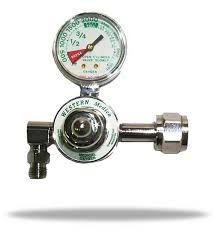
Pressure-Reducing valve

answer
Reduces pressure leaving the tank from 2200 to 40-45 psi
question
Flowmeter

answer
Further reduces pressure of gas to 15 psi, regulates O? entering the system, graduations may be in 100-mL increments until 1-L level & then 500-mL increments after
question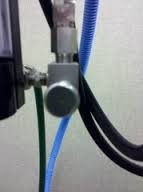
Fast Flush valve

answer
Allows quick infusion of O? into breathing circuit, used in recovery phase to dilute residual anesthetic gases remaining in system & hasten patient recovery, NEVER use w/Non-rebreathing systems, & NEVER use if pressure-relief "pop-off" valve is closed
question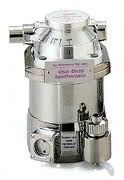
Vaporizer

answer
Inlet- O? enters vaporizer to carry anesthetic gas molecules to patient, outlet- O? & anesthetic gas leave to enter circuit, Holds liquid anesthetic & vaporizes that liquid into a gas form that can be delivered to patient in a controlled manner
question
Factors that effect Vaporizer?
answer
Temperature, Gas flow rate, & Back pressure
question
Precision Vaporizer
answer
Used w/high-vapor-pressure anesthetics, always found out-of-circle, compensates for all 3 factors (Temp, GFR, & BP)
question
Nonprecision Vaporizer
answer
Glass canister that allows liquid anesthetic to vaporize at uncontrolled rate, Use w/anesthetics w/low vapor pressure liquid that vaporize slowly, does not compensate for the 3 factors, less acurate delivery & ? risk for patient
question
Vaporizer-Out-Of-Circuit (VOC)
answer
Not localized in breathing circuit, oxygen from flowmeter enters vaporizer prior to entering breathing circuit, precision vaporizers, & ? resistance gas flow
question
Vaporizer-In-Circuit (VIC)
answer
Oxygen enters breathing circuit from flowmeter, exhaled gases pass through the vaporizer, Nonprecision vaporizers, & ? resistance gas flow
question
Specific-Use vaporizers color codes?
answer
Isoflurane- Purple, Sevoflurane- Yellow, Halothane- Red, & Desflurane- Blue
question
Isoflurane induction Rate & maintenance is?
answer
3-5% induction & 1.5-2.5% maintenance
question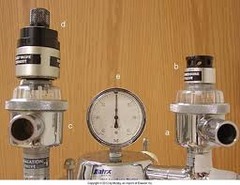
Unidirectional Inspiratory Valve

answer
Letter A on figure, Allows movement of gas in one direction only, during inspiration
question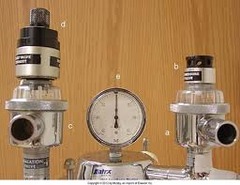
Negative Pressure Relief Valve

answer
Letter B on figure, Safety device if negative pressure results from empty oxygen source is detected in the system, this valve allows room air to enter the system
question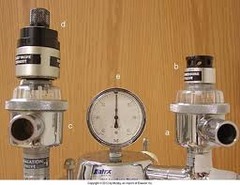
Unidirectional Expiratory Valve

answer
Letter C on figure, Same as inspiratory valve except w/ expired gases, allows movement of gas in one direction during expiration
question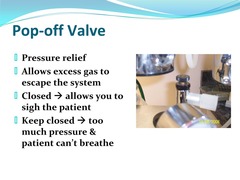
Pop-off Valve

answer
Letter D on figure, Acts as a vent, prevents pressure & build up in the system when completely open, used to determine flow rate techniques, only closed when bagging an a patient squeeze bag then open valve
question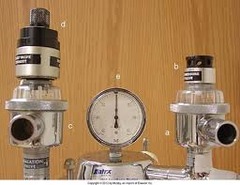
Manometer

answer
Letter E on figure, Pressure gauge of anesthesia machine, measures but not regulates, normal resting pressure when pop-off valve is open- 0
question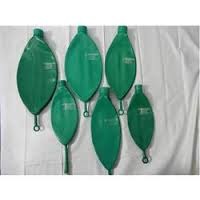
Reservoir Bag

answer
Rubber bag, allows patient to rebreathe some exhaled gases stored in the bag, deflates -inspiration, inflates- expiration, in any circuit it allows manual ventilation of the patient
question
Tidal Volume
answer
Volume of air inhaled during a normal breath at rest, 10mL/Kg bodyweight, then multiply TV by 5
question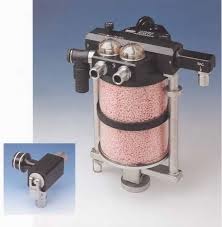
Carbon Dioxide Absorber

answer
During exhalation, waste gases pass to CO? absorber or scavenging system, canister containing barium hydroxide lime or sodium hydroxide lime, crystals absorb exhaled CO? resulting in production of heat, water, & a color change, depleted crystals are hard, 6 to 8 hours of use time to a whole canister then change crystals
question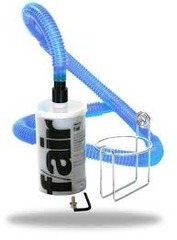
Scavenging System

answer
Evacuates waste gases from anesthesia machine out of surgery suite, active system- mechanical device attached to machine & a building source that produce a vacuum to remove gases, Passive system- relies on gravity, tubing attached to pop-off valve carries waste gases to activated charcoal container, weigh canister before use & reweigh after each use, when gained 50g from initial weight-discard
question
Leak Testing
answer
Before every use, perform w/rebreathing circuit only, check pop-off valve 1st (must be closed), check rebreathing bag & corrugated hose, check Y-piece, check metal rings on inspiratory & expiratory valves, check CO? absorber, & check tubing
question
Rebreathing Circuit
answer
Allows recirculation of some expired anesthetic gases, permits use of lower oxygen flow, some gases are rebreathed, use in patients >7 Kg
question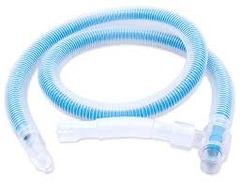
Universal F circuit rebreathing

answer
Design of inspiratory tube inside expiratory tube allows warming of inspired gases, single-tube design is less congested at head & mouth
question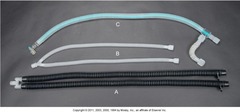
Traditional Circuit Rebreathing

answer
2- Corrugated hoses connected at one end w/Y-piece
question
Non-rebreathing Circuit
answer
No gases are rebreathed, for patients <7 Kg, low resistance for breathing for the patient, ? expense because of the amount of oxygen used
question
Oxygen Flow Rates
answer
Rebreathing- ? OFR for induction & recovery, w/large-volume delivery of gas, maintenance flow is ? than induction & recovery Non-rebreathing- ? OFR continuously
question
Pulse oximeter is to ______ _______ as a capnograph is to ________ ________ ________?
answer
Oxygen saturation, carbon dioxide levels
question
Internal organ that is most vulnerable to over oxygenation?
answer
Lung
question
When oxygen is administered through a nasal catheter into the trachea, what % of reduction in oxygen flow should there be?
answer
50%
question
CO? measurement can only be performed in what situation?
answer
Intubated anesthetized animals
question
The Gold Standard test when monitoring for overall oxygenation ability of a patient is?
answer
PaO?
question
Oxygen delivery to the body depends on what 3 things?
answer
Heart output, arterial oxygen content, & blood flow
question
Normal animals should have an SpO? in what range?
answer
98-100
question
An animal that is taking prolonged inspirations may have what kind of obstruction?
answer
Foreign body in upper airway
question
A normal CO? range is?
answer
35-45 mmHg
question
PaO? is measured on what kind of blood sample?
answer
Arterial
question
When an animal is in respiratory distress the best position for them to be in physically is in sternal recumbency. True or False?
answer
False, lateral recumbency
question
Elizabethan collars may be used to administer oxygen. True or False?
answer
True
question
An animal may acquire oxygen toxicity by administering too much oxygen to them. True or False?
answer
True
question
Four signs of respiratory distress in a Dog or Cat
answer
SpO? ?, cyanosis, prolonged inspirations, & RR ?
question
Five things a Technician can do to assess an animal in respiratory distress
answer
Check character of animal (positioning, awareness, etc), PE, Radiographs, check MM, get RR



